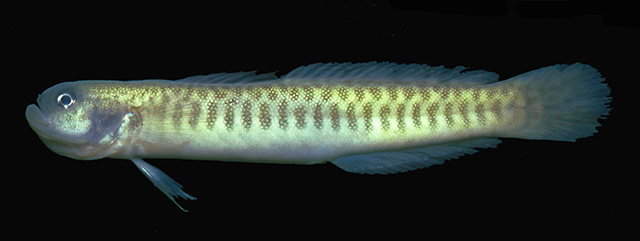|
Dorsal spines (total): 7; Dorsal soft rays (total): 19; Anal spines: 1; Anal soft rays: 18; Vertebrae: 26. This species is distinguished by the following characters: lower lip with free ventral margin posteriorly only; compressed head and body; elongate body; nape, cheek, preoperculum and operculum almost completely covered with scales; body covered with cycloid scales, imbricate, in 105 vertical rows; terminal mouth slightly protractile, forming an angle of about 60° to longitudinal axis of body; maxilla reaching posteriorly to below front margin of eye; head pores are all paired laterally, 5 pores around dorsal margin of each eye; relatively short and rounded snout, with length subequal to eye diameter; anterior nostril is at the end of short tube while posterior nostril is a simple pore; no teeth on vomer, tongue and palatines; conical teeth slightly curved; 2 rows on upper jaw, small, loosely attached anteriorly while teeth in outer row slightly larger, widely spaced; lower jaw with single row of loosely attached, small teeth directed dorsally, without enlarged curved canines visible in holotype; along outer edge of dentary is a series of blunt bony dorsoventrally flattened projections with rounded tip directed more or less horizontally (widely-spaced projections appear to be bony projections of dentary, not true teeth, but probably tooth sockets), space between projections about equal to width of projections; tongue tip is broadly rounded; head papillae in transverse pattern; median nuchal crest, formed by low fold of skin from first dorsal spine onto head, low; gill opening vertical, extending ventrally from pectoral-fin base below upper margin to point just below lower pectoral base, below operculum; fleshy interorbital is subequal to diameter of eye; D1 VI, D2 I,19; A I,18; pectoral-fin rays 19; segmented caudal rays 9+8; branched caudal rays 8+7; pelvic fins are separate I,4; vertebrae 12+14 (Ref. 83368). |

